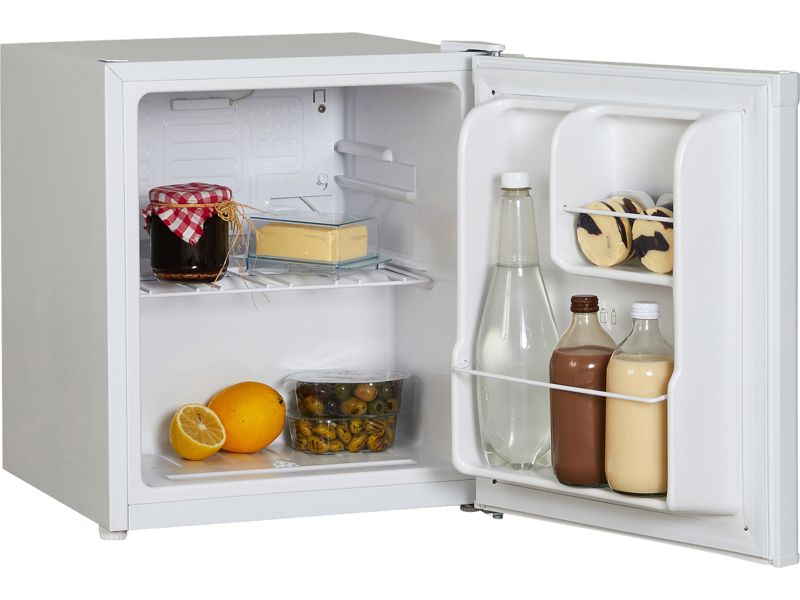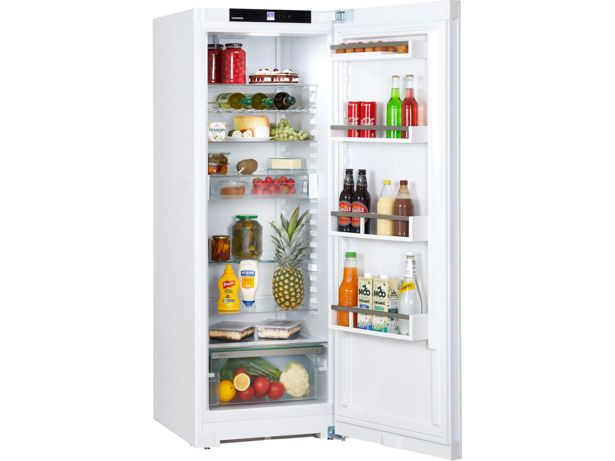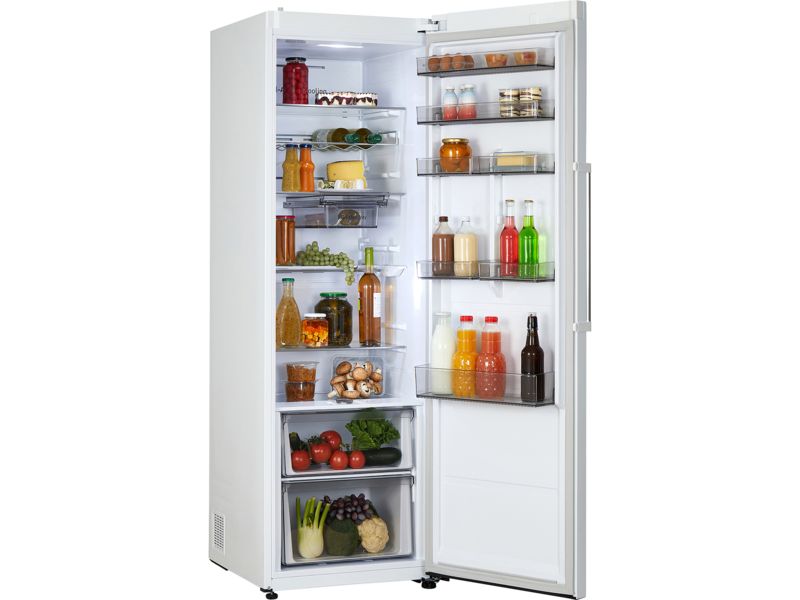What temperature should a fridge be?

Your fridge and the way you're using it could mean your food is going off more quickly than you'd like. In the worst cases, it could even lead to you getting ill.
But it's about much more than simply twiddling your thermostat. From picking the right shelves for certain food types to handling leftovers properly, we run through some key tips to keeping your food safely stored in the fridge.
See which fridges we recommend in our guide to the best fridges.
What is the ideal temperature for a fridge?
If you want to get the most out of your food, the temperature in your fridge needs to be between 0°C and 5°C. At anything over 8°C, most harmful bacteria can grow rapidly on your food - it's commonly referred to as the danger zone for microbial growth.
The faster your fridge gets down to within that 0°C-5°C temperature range, and the longer it's able to stay there, is key to maximising the amount of nutrients in your food.
Temperature accuracy matters
Your fridge won't just automatically set to within that temperature range. You need to set it up using the manufacturer's recommended setting, which you'll find in the instruction manual.
You also need a reliable fridge, as our testing has found that you can't always rely on these settings to work like they should.
The manufacturer's recommended setting on the worst models we've seen sends the temperature in the fridge soaring above 10°C – warm enough to invite heat-loving bacteria inside.
Every degree really does count. If you're not convinced by the accuracy of your fridge thermostat, you can pick up a fridge thermometer for less than £10.
Video: how to organise your fridge
No matter how accurate your thermostat is, the temperature in your fridge will still vary between shelves. It's best to think of your thermostat temperature as an average for the fridge because, as a general rule, the higher the shelf, the higher the temperature will be.
But that's no bad thing – provided you make use of these different temperatures to get the best out of your food by storing it in the right position.
Top shelves
- Cured meats, leftovers or cream cakes and any other items that don't need to be cooked before being eaten are best stored on the upper shelves.
Middle shelves
- Eggs are often stored on the door racks, but the door is commonly one of the warmest parts of the fridge and is also prone to temperature fluctuations. Your eggs will fare much better in the more stable and cooler temperatures around the middle zone of the fridge.
- Dairy products including cheese, butter, yoghurt.
Bottom shelves
- Raw meat, poultry and seafood, which should be kept between 0°C and 3°C in order to lock in freshness and prevent harmful bacteria from tucking in are best stored on the bottom shelves as they are the coldest. Raw meat, poultry and seafood should be stored in sealed containers, so they can't touch or drip onto other food.
Drawers
- Fruit and vegetables are best stored in separate drawers.
Storing fruit and vegetables

Both fruit and vegetables will stay fresher for longer if you store them at the correct humidity. Vegetables tend to like high humidity, while most fruits prefer low. If you have a humidity switch on your fridge drawer(s), make sure you switch it to high humidity for veg and low humidity for fruit.
If you don't have a switch or only have one drawer, it's best to keep your veg in the drawer as that tends to prevent moisture from escaping and is therefore more humid. Your fruit can then go on a middle shelf in your fridge.
You shouldn't store fruit in a drawer that doesn't have a switch or contains vegetables. It's likely to produce ethylene, a natural gas that can over-ripen other fresh food when trapped in a confined space.
There are some exceptions to the rule to be aware of, though. Mushrooms are a vegetable that produces ethylene, while apples and watermelons are fruits that are sensitive to the effects of ethylene.
Storing condiments

Open any fridge and you're likely to find a condiment of some sort on a door rack, which is exactly where they should be. The presence of natural preservatives, such as vinegar, in many condiments means they don't need to be kept in the much cooler parts of the fridge.
But if you find yourself stocking up on lots of different sauces and running out of room on the fridge door, you might be wondering if you could get away with keeping some out of the fridge.
We spoke with Dr Sarah Schenker, a public analyst, special adviser on food and drink, and registered dietitian, to find out which condiments should be kept in the fridge and which ones you can keep in the cupboard.
Keep these condiments in the fridge:
- Maple syrup: In anything with a sugar content of more than 60%, the sugar acts as a preservative to keep microbial degradation at bay. Maple syrup falls just short of this, allowing some moulds to get a hold, so store it in the fridge. If you keep it in a cupboard, you may find mould forming, especially on the lid because of its exposure to air when you open it.
- Mayonnaise: Although it contains vinegar, there’s not enough in there to safely store this creamy, egg-rich condiment outside the fridge. Refrigerating mayonnaise will limit the growth of bacteria that you might have introduced by dipping cutlery into the jar.
- Pesto: Pesto should definitely be refrigerated. Nuts in pesto mean it can end up developing mould that produces toxic compounds called mycotoxins, including dangerous aflatoxin, a bacteria that can cause serious liver damage.
- Salad cream: Although salad cream contains the preservative potassium sorbate, as well as spirit vinegar, it also contains egg. Therefore, much like mayonnaise and tartare sauce, it should be refrigerated.
- Tartare sauce: Tartare sauce contains egg, and also has low acidity and a high water content, which microorganisms love, so this is definitely one to keep in the fridge.
To find out more about why some condiments can be stored unrefrigerated, check out the full article on where to store your condiments.
Food you should not store in the fridge
There are a number of foods that are typically stored in the fridge that can actually quickly lose flavour and freshness as a result. Others can become outright unsafe if stored in cold conditions. Here are a few foods you might consider keeping out of the fridge in order to get the best from them and one you definitely shouldn't refrigerate.
- Bread: The cool, dry conditions inside a fridge will dehydrate your loaf, leaving you with stale-tasting slices. Keep it in a bread bin instead. Alternatively, freezing it won't cause it any problems and you can resurrect your slices in a toaster or under the grill.
- Cucumbers: This refreshing salad staple actually fares better when kept out of the fridge. Cold conditions can cause the skin to shrivel and the inside to become slightly mushy. For best results, store them in a cupboard if you have space or in a bowl on a countertop. If you want them cold for your salad then put them in the fridge an hour before prep and you'll get the refreshing chill without the cucumber feeling the negative effects of long-term cold exposure.
- Tomatoes: Just like with cucumbers, low temperatures can alter the texture of a tomato, leaving it with a coarse feel in the mouth. Worse still, chilling tomatoes inhibits the activity of enzymes inside the fruit that help give it its flavour. Another one to keep in a bowl at room temperature.
See What temperature should a freezer be? for advice on storing food in the freezer.
Understanding best-before and use-by dates

Paying attention to the use-by and best-before dates on products will help you keep your food safe to eat.
Use-by dates
Keep in mind that for the use-by date to be a genuinely useful guide, you must follow the storage instructions as written on the label, such as 'keep refrigerated after opening'. Not following these instructions could lead to the food spoiling more quickly and increasing your risk of food poisoning.
It's possible to 'extend' the use-by date if you freeze the item before it expires, but make sure you follow any instructions on the pack - such as 'freeze on the day of purchase'. Likewise, when you get around to cooking it, make sure you follow any additional instructions that might indicate it can be cooked from frozen or that it needs to be defrosted thoroughly and used within 24 hours.
Best-before dates
Sometimes shown as BBE (best before end) on a product label, this date serves as an indication of when the quality of the food or drink may be beyond its best. For the most part, it's not a safety concern if you eat food after this date, but the flavour or texture of the product might not be at the level you're expecting.
Eggs are an exception, though. Eggs will have a best-before date of no more than 28 days after they have been laid. By law, eggs must be sold (the sell-by date) no later than 21 days from the date they've been laid. So from the time of purchase you'll have at least seven days to use them.
The quality of the egg will start to diminish after the best-before date, and in the rare instance that salmonella bacteria is present, it may begin to multiply to high levels that could make you ill.
If you decide to use eggs that are beyond the best-before date, make sure you do so in dishes that will be cooked thoroughly.
If you're in the market for a new refrigerator, our guide to the best fridges will help you choose a decent one.
More food storage tips

Don’t stack food too high in the fridge
Once you have the gist of where to put what inside the fridge, you'll still want to avoid packing things so full that food on one shelf is touching the shelf above.
Doing so can prevent cool air from circulating, pushing up the temperature in parts of the fridge and inviting heat-loving bacteria to tuck into your food.
As part of our tests, we measure usable volume so you know exactly how much storage space you're actually getting compared to what the manufacturer says you're getting. The worst will give you 34% less storage space than you'd been led to believe.

Let leftovers cool to room temperature
You should always let leftovers cool to room temperature before putting them inside your fridge. But take care not to leave them sitting out for more than a couple of hours.
Otherwise, the warmth of your recently cooked food will send the temperature in your fridge skyrocketing.
Not only will that reduce the freshness of other food in the fridge – which needs to be kept at a stable temperature – it will also force your fridge to work harder to cool down, pushing up your energy bills.

Keep your fridge clean to prevent bacteria
Every time you unpack groceries, you introduce new microbes into the fridge, so it's no big surprise that most fridges are teeming with bacteria.
In many cases these are harmless, but during an investigation we carried out into the types of bacteria commonly found inside fridges, we were concerned by the presence of Aeromonas bacteria, Enterobactera clocae and Klebsiella oxytoca, among others.
These germs are linked with respiratory and urinary infections, especially for people with existing health problems or weakened immune systems. They’re likely to have come from unwashed vegetables, highlighting the importance of cleaning your fridge regularly.
Along with ensuring it's set at the correct temperature, regular cleaning will help to remove bacteria and prolong the life of your food. Cleaning regular touch points on the fridge, including the handles and the door trays, can also prevent the spread of bacteria.
We give every fridge we test a rating for how easy it is to clean. The worst have few removable parts and lots of nooks and crannies capable of harbouring stray crumbs. You can find out more about the tough assessments we carry out to separate the best from the worst by reading our guide to how we test fridges.
Is your fridge dirty or smelly? Read our guide on how to deep-clean your fridge.


